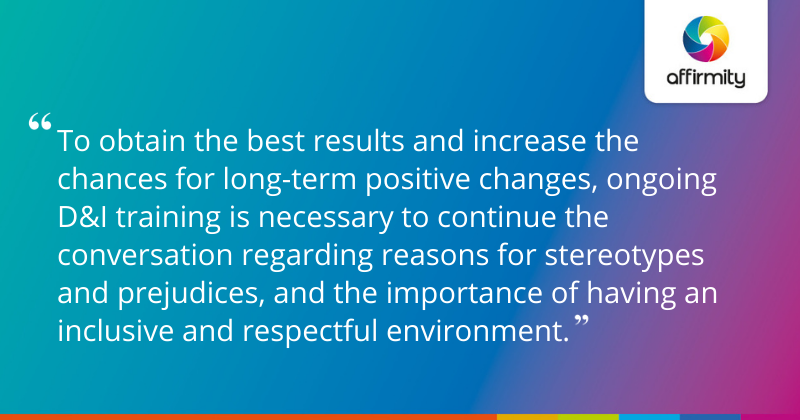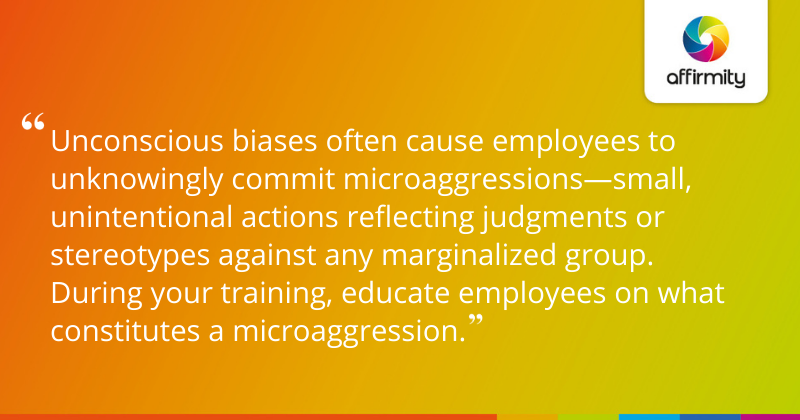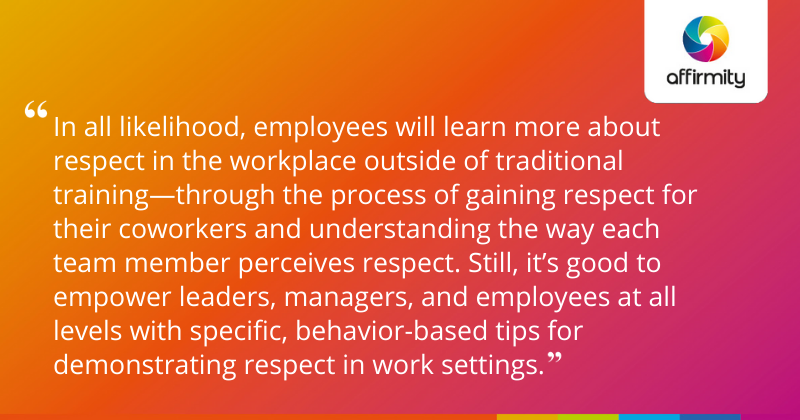Because discriminatory behaviors are rooted in unconscious beliefs and thought patterns, successful training must both raise awareness and empower people to act differently. To explore those underlying beliefs and thought patterns, D&I training programs should add in-depth sessions on the three critical topics in this article.
Despite more than a half-century of experience amassed across large, smart, and well-meaning organizations, a Harvard Business Review study found that improperly designed and delivered diversity training may actually create less diverse organizations.
The study found that diversity training is most effective when programs are designed to:
- Emphasize the positive and avoid blaming and shaming
- Focus on social accountability and take an open and accepting approach
- Encourage engagement and interaction among groups
- Appeal to the human desire to earn the respect of others.
The same study found that people resist mandatory training, and that undermines the goals of the session, no matter how worthwhile and business-critical.
The good news is that researchers found that voluntary training did lead to increases in diversity across all groups over a five-year period.
Clearly, organizations must take a strategic approach to designing diversity training if they really want to impact organizational change. Instead of simply presenting information about diversity, training must be designed to change behaviors, with interactive and collaborative exercises that will build an inclusive environment. Add the following to your D&I training programs to achieve your goal:

1. Unconscious Bias
Because unconscious bias is rooted in the brain, making people aware of stereotypes that dwell in their subconscious is the first step to changing biased decisions and behaviors. Another objective of unconscious bias training should be to highlight the potential impact on decisions and behaviors, and to learn ways to minimize the negative impacts on your organization.
To obtain the best results and increase the chances for long-term positive changes, ongoing D&I training is necessary to continue the conversation regarding reasons for stereotypes and prejudices, and the importance of having an inclusive and respectful environment.
According to The Real Effects of Unconscious Bias in the Workplace, produced by UNC Kenan-Flagler Business School, truly effective training provides a safe space for employees to identify their personal biases and learn to overcome them.
Training Exercise
The Harvard Business Review reported that perspective-taking can help people change biases.
Have employees imagine challenges faced by a specific marginalized minority, and then write a few sentences about each challenge. By putting themselves in others’ shoes, research showed that employees were able to develop a more positive attitude and behavior toward minority groups.
MORE ON THE SUBJECT | ‘Avoiding Unconscious Bias: 6 Insights That Will Help You Take Action Immediately‘

2. Microaggression
Unconscious biases often cause employees to unknowingly commit microaggressions—small, unintentional actions reflecting judgments or stereotypes against any marginalized group.
During the training, educate employees on what constitutes a microaggression. In a study on gender bias against women of color in science, Hasting College identified four common patterns of this type of behavior that affect minority or marginalized groups in the workplace.
Training Exercise
Break employees into small groups and distribute worksheets. Have employees discuss examples and the possible interpretations, then consider alternate, nondiscriminatory language or actions for situations they experience at work.
Employees can also share examples of microaggressions they have experienced or witnessed. Once again, have the group brainstorm alternate language or actions for each situation.
ALSO ON THE BLOG | ‘3 Key Ways to Build a Culturally-Aware Climate in Your Organization‘

3. Respect
Expectations regarding respect and perceptions of disrespect vary widely—culturally and individually. While this makes the concept challenging to address in formal training, its importance cannot be understated. A diverse and inclusive, accepting culture happens only when all employees feel respected.
Many organizations find video learning—for example, examples of managers performing evaluations, conducting job interviews, or discussing compensation decisions—can increase awareness of behaviors perceived as disrespectful.
In all likelihood, employees will learn more about respect in the workplace outside of traditional training—through the process of gaining respect for their coworkers and understanding the way each team member perceives respect. Still, it’s good to empower leaders, managers, and employees at all levels with specific, behavior-based tips for demonstrating respect in work settings.
Training Exercise
Because team-building is tied closely to respect, use J.T. O’Donnell’s Team Decoding exercise with groups that collaborate regularly. This 30-minute exercise is an ideal activity for a standing meeting or team lunch.
HAND-PICKED FOR YOU | ‘Advanced Diversity & Inclusion Planning: Experts Address 11 Key Issues‘
Combining Training with Accountability and Support
By combining courses and exercises focused on these three topics, your organization can augment and strengthen your existing D&I training program—which is an integral part of your overall D&I initiative. It’s important to note, however, that training can only drive change when combined with accountability and support for leaders.
